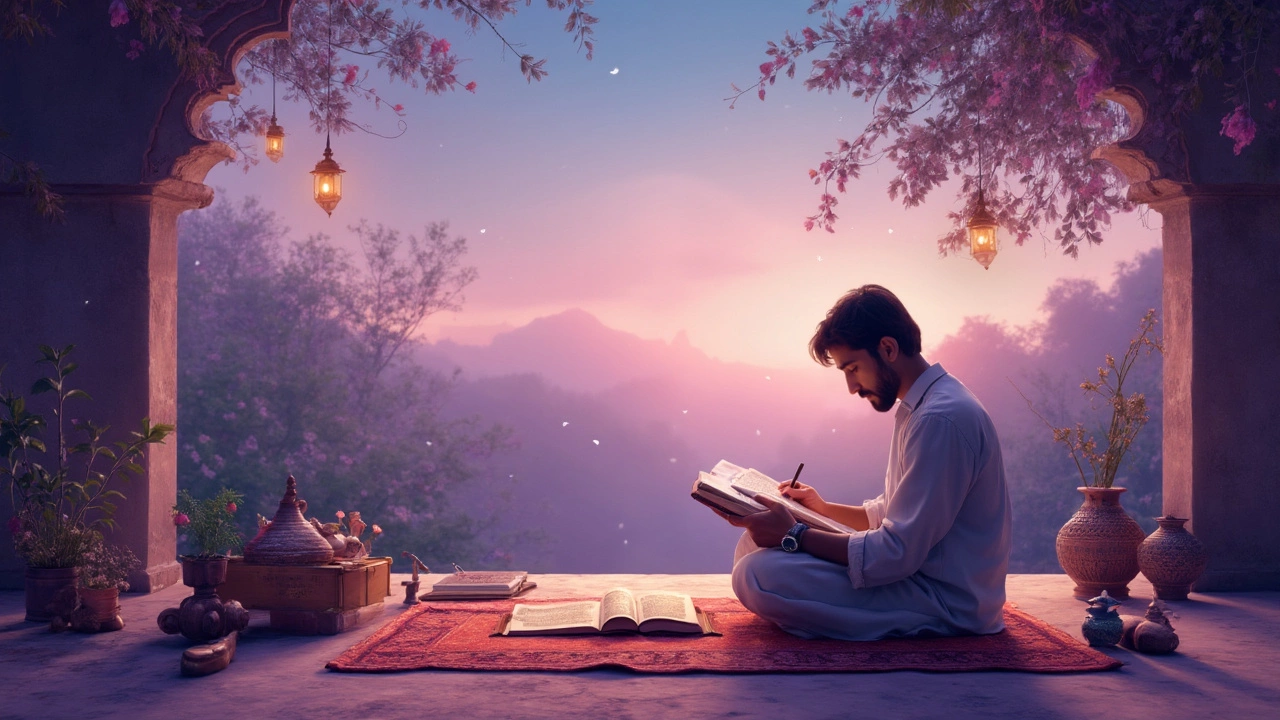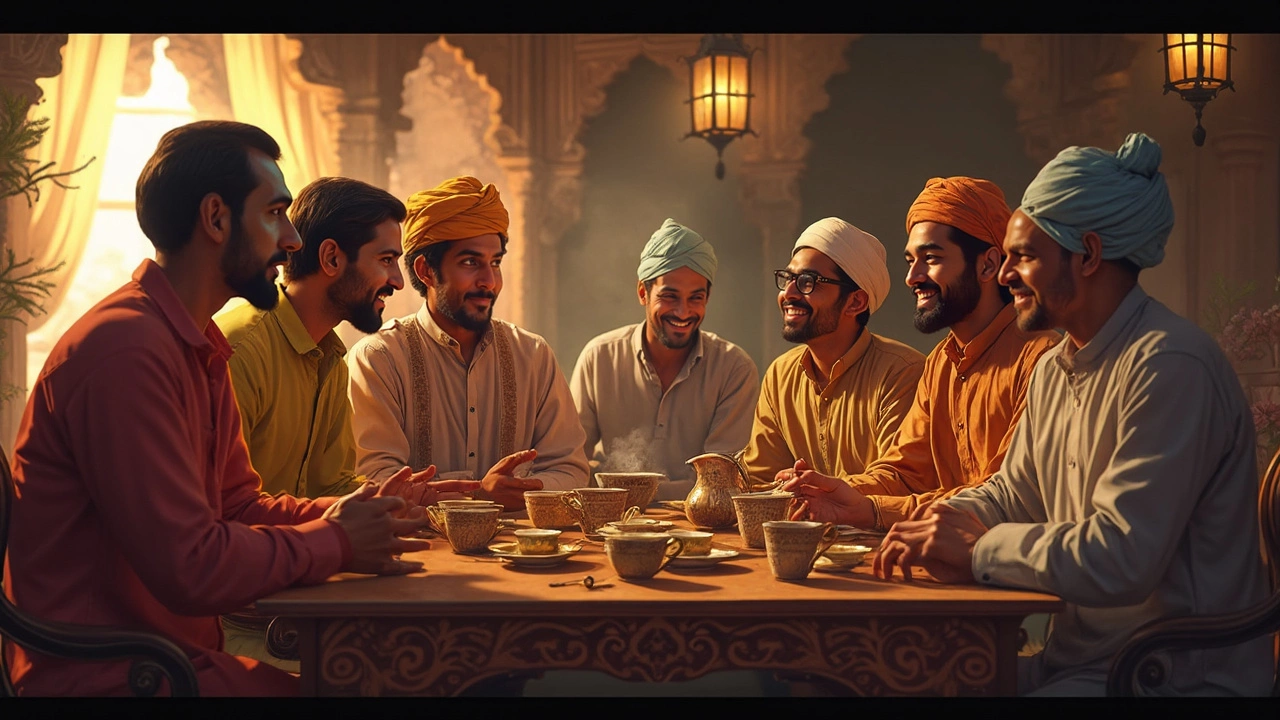Is Ghazal Male or Female?
 Mar, 30 2025
Mar, 30 2025
Ever listened to a ghazal and wondered if it carries any gender? This question might sound quirky, but it’s an interesting way to dive into the world of ghazals. Traditionally, ghazals originate from Arabic poetry but have made their mark in Indian culture. They're famous for voicing deep feelings—often about love, loss, and longing.
So, what’s with the gender thing? Well, in the literary world, many forms of art and expression often get tagged with gender stereotypes. But the beauty of a ghazal lies in its universality. Though it primarily features themes of love and longing, these themes don’t cater to any single gender. Instead, a ghazal captures what’s universally human.
If you're curious about the real magic behind ghazals and how they resonate with emotions beyond gender, you’re in the right place. We’ll explore more about their history and why they may be just what you need to add a touch of poetic flair to your day. Stick around to see how these poetic gems transcend traditional boundaries!
- Understanding Ghazals
- Historical Roots of Ghazals
- Ghazal's Emotional Appeal
- Language and Style
- Ghazals and Gender Perception
- Tips for Appreciating Ghazals
Understanding Ghazals
Alright, let's break down what a ghazal really is. A ghazal is a poetic form that dates back centuries and has traveled across cultures and lands. Originally from Arabic poetry, its influence has spread across South Asia, especially in India, Pakistan, and Iran, becoming part of cultural heritage.
At the heart of a ghazal lies its unique structure. It’s composed of couplets, known as 'sher' in Urdu. Each couplet stands alone in terms of content but is interconnected through rhyme and refrain. The magic here is that each sher is like a tiny poem on its own, yet together they weave a larger, cohesive tapestry of emotion.
Now, get this—ghazals often deal with themes of love, heartbreak, and longing, universal feelings that know no boundaries. This makes them resonate deeply with people from different backgrounds. The first couplet sets the mood and rhyme that's continued throughout the rest of the ghazal, providing a kind of musicality and rhythm that's simply captivating.
Language is another intriguing part of ghazals. While many classic ghazals are in Persian, Urdu, or Hindi, translations and adaptations exist in other languages too, bringing this art form to a wider audience.
One of the refreshing aspects of ghazals is their ability to express intense emotions through brevity and precision. Rather than long-winded verses, they focus on capturing powerful feelings in just a few words, often with a punchy twist at the end of each sher. This makes them quite engaging, even if you're not particularly poetry-crazy!
If you've ever tried penning down emotions or enjoyed emotion-driven art, you’ll find a kindred spirit in ghazals. They’re all about expressing those complex feelings we all have but sometimes struggle to articulate. That's what makes them so timeless and relatable.
Historical Roots of Ghazals
If you've ever been curious about the origins of the ghazal, you're in for a fascinating journey. The ghazal form dates back to the 7th century and holds its roots in Arabic poetry. Originally, these short poems were a medium to express love and separation—emotions that know no gender. They gained popularity at the royal courts of the ancient Persian Empire, where poets composed them to entertain the ruling elite.
As time went on, the ghazal spread to the Indian subcontinent, thanks to the influence of Persian culture. During the Mughal era in India, ghazals blossomed. They were not just limited to Persian but also embraced local languages like Urdu, Hindi, and Punjabi. This cross-cultural adoption led to the evolution of the ghazal, shaping it as we know today in India's rich poetic tradition.
Notable poets like Mirza Ghalib and Faiz Ahmed Faiz became iconic figures in ghazal poetry, contributing significantly to its growth. Their works often reflected personal and political themes, attracting a diverse audience. The ability of ghazals to adapt and reflect societal changes kept them relevant throughout centuries.
Today, ghazals are celebrated worldwide, reflecting their historical journey and the diverse influences they've absorbed along the way. Whether it's through music or written verse, their emotional depth continues to captivate audiences, transcending time and cultural barriers.
Ghazal's Emotional Appeal
Why is the ghazal such a hit when it comes to tugging at heartstrings? It all boils down to the way these poems express common human emotions with raw simplicity. Think of them as the OGs of emotional storytelling, long before streaming dramas had us reaching for the tissue box.
A ghazal is like a journey through the heart. It's crafted to articulate feelings of love, separation, and longing as if it were your own diary entry. This emotional resonance is why ghazals never go out of style. Whether you’re feeling blue or head over heels, there’s probably a ghazal that captures your mood perfectly.
Would you believe that ghazals date back to the 6th century? Originating in ancient Arabic culture, they made their way into Indian literature around the 12th century. Their persistent popularity speaks to their ability to connect across time, cultures, and language barriers. This cross-cultural journey has enriched them, turning them into varied emotional canvases that people use to portray personal stories.
Now, the magic of ghazals isn't just in the words but also the melody. Many ghazals are set to music, making those heartfelt words even more compelling. When a ghazal is sung, it opens an entirely different realm of experience. Listeners get lost in the harmony, further amplifying the emotional impact.
- Some famous ghazals by artists like Jagjit Singh and Mehdi Hassan are cherished by many across the globe.
- These artists have helped bring the ghazal into modern living rooms, proving its timeless appeal.
So, whether it's the words, themes, or melodies, the emotional appeal of a ghazal is truly unmatched. They're like little packages of heartfelt wisdom that never fail to resonate with anyone who takes a moment to listen.

Language and Style
The language of a ghazal plays a huge role in its charm and appeal. Typically, ghazals are written in Urdu, but over time, poets have explored them in other languages like Hindi and Persian. It's the way words and emotions are woven together that makes ghazals so captivating.
One captivating aspect of ghazals is their specific structure. A ghazal is composed of rhyming couplets, known as 'shers.' Each couplet is independent but contributes to the overall theme of the piece. This gives ghazals an elegant, almost musical flow. Imagine hopping from one heartfelt expression to the next, each telling its own story, yet part of a larger picture.
Rhyme and refrain are key in the style of a ghazal. Each line in the couplets adheres to a specific meter, and the end of every second line typically repeats a word or phrase, known as the 'radif.' It's kind of like a poetic catchphrase that ties everything together. There’s also the 'matla', a special couplet where the rhyme scheme first emerges.
Let's not forget about the emotional tone. Whether it's about unrequited love or existential musings, ghazals express raw, intense emotions. This universal nature helps them transcend cultural and gender boundaries. Below is a simple example to illustrate the common structure of a ghazal:
| Element | Description |
|---|---|
| Radif | The repeating word or phrase at the end of the second line in each couplet. |
| Matla | The opening couplet where the rhyme scheme is introduced. |
| Shers | Individual rhyming couplets contributing to the theme. |
Want to dive deeper? Just grab a collection of ghazals, sit in a cozy spot, and let the words transport you. They’re simple and complex all at once, a bit like life itself.
Ghazals and Gender Perception
It’s interesting to think about how we assign gender to art forms, but when it comes to ghazals, this idea kind of falls apart. You might hear a ghazal performed by a male or female artist and wonder if it gives the piece a sort of masculine or feminine vibe. Yet, in reality, ghazals are all about connecting on a heart-to-heart level, not a gender-to-gender level.
The gender perception of ghazals often comes from the voice delivering it and the themes within the poetry. Traditionally, ghazals were penned in male-centric perspectives, especially when dealing with themes of romantic longing. However, as more female poets and singers have embraced this form, the themes have naturally diversified, proving that emotions in a ghazal don’t belong to a single gender.
What's also worth noticing is the language of ghazals—it’s super flexible. Whether it’s Urdu, Hindi, or even English, the style adapts to the one expressing the emotions, making it easy for anyone, irrespective of gender, to pour their heart out. Perhaps that’s why it feels like ghazals are non-binary—they belong to everyone and no one at the same time.
A cool fact: In India, many legendary ghazal singers, regardless of their gender, have made a massive impact across cultural lines. Be it Jagjit Singh, with his deeply resonant voice, or Begum Akhtar, who just grips you with her emotional depth—their ghazals touch souls universally. This shows that the person behind a ghazal matters more than any superficial gender tag we might place on it.
In conclusion, the essence of ghazals is all about emotion and connection, skipping over any barriers gender might try to place. So, whether you see yourself as a reader, a writer, or a listener, let the beauty of a ghazal make its mark. After all, it’s all about feeling, not gendering!
Tips for Appreciating Ghazals
Getting into the world of ghazals can feel a bit like stepping into a new culture. But with these simple tips, you’ll find yourself deep in their emotional and melodic charm.
First, start with the classics. Handmade by legends like Jagjit Singh and Begum Akhtar, these tunes strike a chord with listeners worldwide. Make it a point to listen actively, focusing on the lyrics and the subtle twists in the melody.
- Understand the Language: Most ghazals are in Urdu or Hindi. Knowing the meanings of words can significantly enrich your experience. There are plenty of resources online to get you started.
- Attend Live Performances: If you can, go for a live ghazal night. The atmosphere of a live performance can make you feel the emotion in a more personal way. It's like attending a heartfelt dialogue with the poet.
- Dive into the Themes: Focus on the emotions and stories the ghazal tells. Whether it’s about love, separation, or togetherness, try to relate these emotions to your own experiences for a deeper connection.
- Create a Playlist: Make a playlist with different artists to explore the variety and richness of ghazals. This way, you can savor different styles and interpretations of this beautiful art form.
- Join Communities: Look for online forums or social media groups of ghazal enthusiasts. This can be a fun way to share your favorite ghazals and discover new ones.
Remember, appreciating a ghazal is more about feeling than understanding. Let the music and words touch your heart. You're sure to find a new appreciation for not just ghazals, but poetry and music in general. Enjoy the journey!